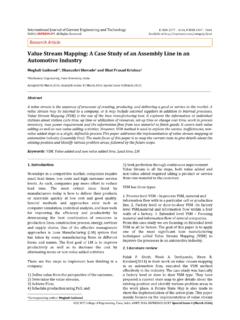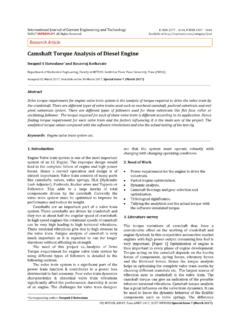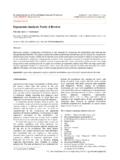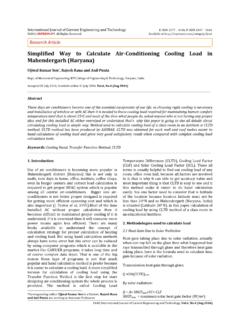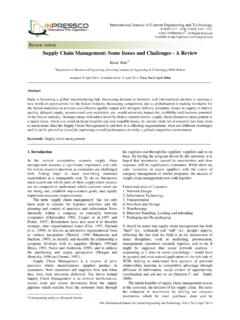Transcription of Image Encryption & Decryption with Symmetric Key ...
1 International Journal of Current Engineering and Technology E-ISSN 2277 4106, P-ISSN 2347 5161 2015 INPRESSCO , All Rights Reserved Available at Research Article 448| International Journal of Current Engineering and Technology, , (Feb 2015) Image Encryption & Decryption with Symmetric Key cryptography using MATLAB Jai Singh *, Kanak Lata and Javed Ashraf Dept. of Electronics & Comm., Maharshi Dayanand University, Rohtak, Haryana, India Dept. of Electronics & Comm., Jamia Milia Islamia University, New Delhi, India Accepted 20 Feb 2015, Available online 25 Feb 2015, , (Feb 2015) Abstract Any communication in the language that you and I speak that is the human language, takes the form of plain text or clear text.
2 That is, a message in plain text can be understood by anybody knowing the language as long as the message is not codified in any manner. So, now we have to use coding scheme to ensure that information is hidden from anyone for whom it is not intended, even those who can see the coded data. cryptography is the art of achieving security by encoding messages to make them non-readable. cryptography is the practice and study of hiding information. In modern times cryptography is considered a branch of both mathematics and computer science and is affiliated closely with information theory, computer security and engineering. cryptography is used in applications present in technologically advanced societies; examples include the security of ATM cards, computer passwords and electronic commerce, which all depend on cryptography .
3 There are two basic types of cryptography : Symmetric Key and Asymmetric Key. Symmetric key algorithms are the quickest and most commonly used type of Encryption . Here, a single key is used for both Encryption and Decryption . There are few well-known Symmetric key algorithms DES, RC2, RC4, IDEA etc. In this Project digital images encrypted and decrypted by using Symmetric key cryptography using MATLAB. Keywords: DES, Cryptograph, Symmetric Key, Encryption , Decryption , Cipher, Encipher, Image Encryption . 1. Introduction 1 cryptography , then, not only protects data from theft or alteration, but can also be used for user authentication. There are, in general, three types of cryptographic schemes typically used to accomplish these goals: secret key (or Symmetric ) cryptography , public key (or asymmetric) cryptography , and hash functions.
4 The rapid continuous increase in exchange of multimedia data over protected and unprotected networks such as the worldwide available internet and local networks such as shared networks and local area networks etc has encouraged activities such as unauthorized access, illegal usage, disruption, alteration of transmitted and stored data. This widely spread use of digital media over the internet such as on social media, won cloud storage systems etc and over other communication medium such as satellite communication systems have increased as applications and need for systems to meet current and future demands evolved over the years. Security concerns with regards to such data transmission and storage has been a major concern of both the transmitters and receivers and hence the security of critical cyber and *Corresponding author: Jai Singh physical infrastructures as well as their underlying computing and communication architectures and systems becomes a very crucial priority of every institution.
5 cryptography is the fundamental platform in which modern information security, which involves the use of advanced mathematical approaches in solving hard cryptographic issues, has gained its grounds in the digital world. This has evolved from classical Symmetric , in which shifting keys are normally used as well as substitution methods, ciphers to modern public key exchange cryptosystems, which aims to make cryptanalysis a difficult approach to deciphering ciphers, eg. RSA, ElGamal, elliptic curve, Diffie-Hellman key exchange, and they are used in digital signature algorithms and now cutting edge works such as the quantum cryptography . 2. Related Work Secret key cryptography schemes are generally categorized as being either stream ciphers or block ciphers.
6 Stream ciphers operate on a single bit (byte or computer word) at a time, and implement some form of feedback mechanism so that the key is constantly changing. Jai Singh et al Image Encryption & Decryption With Symmetric Key cryptography Using Matlab 449| International Journal of Current Engineering and Technology, Vol., No. (Feb 2015) Secret key cryptography schemes are generally categorized as being either stream ciphers or block ciphers. Stream ciphers operate on a single bit (byte or computer word) at a time, and implement some form of feedback mechanism so that the key is constantly changing.
7 Symmetric Key cryptography Process In above Blocks are given which is implemented step by step for Image Encryption by using Symmetric key cryptography for Encryption and Decryption . cryptography Terminology a) Plaintext: The original intelligible message. b) Cipher text: The transformed message. c) Cipher: An algorithm for transforming an intelligible message to unintelligible by transposition. d) Key: Some critical information used by the cipher, known only to the sender & receiver. e) Encipher: (Encode) the process of converting plaintext to cipher text using a cipher and a key. f) Decipher: (Decode) the process of converting cipher text back into plaintext using a cipher & key. g) Cryptanalysis: The study of principles and methods of transforming an unintelligible message back into an intelligible message without knowledge of the key.
8 Also called code breaking h) Cryptology: Both cryptography and cryptanalysis i) Code: an algorithm for transforming an intelligible message into an unintelligible one using codes. j) Hash algorithm: Is an algorithm that converts text string into a string of fixed length. k) Secret Key cryptography (SKC): Uses a single key for both Encryption and Decryption . l) Public Key cryptography (PKC): Uses one key for Encryption and another for Decryption . m) Pretty Good Privacy (PGP): PGP is a hybrid cryptosystem. n) Public Key Infrastructure (PKI): PKI feature is Certificate authority. 3. Image Encryption This paper based on Image Encryption & Decryption . The user will give an input and Encryption factor.
9 The Image will be converted to an encrypted Image file. This Image is not understandable by any one. When the receiver will receive the encrypted file he will decrypt it so he will get the original file. We have used a simple GUI for our cryptosystem. We have used three push buttons in our GUI representing 1. Input Image Select 2. Encrypt Image 3. Decrypt Image Image Encryption approaches fall into two broad categories: spatial domain methods and frequency domain methods. The term spatial domain refers to the Image plane itself, and approaches in this category are based on direct manipulation of pixels in an Image . In these algorithms, the general Encryption usually destroys the correlation among pixels and thus makes the encrypted images incompressible.
10 Frequency domain processing techniques are based on modifying the Fourier transform of an Image . The Fourier transform can be reconstructed (recovered) completely via an inverse process with no loss of information. This is one of the most important characteristics of this representation because it allows us to work in the Fourier domain and then return to the original domain without losing any information. Encryption techniques based on various combinations of methods from these two categories are not unusual. In this paper we present a novel Image Encryption scheme which employs magnitude and phase manipulation using Differential Evolution (DE) approach. It deployed the concept of keyed discrete Fourier transform (DFT) followed by DE operations for Encryption purpose.
